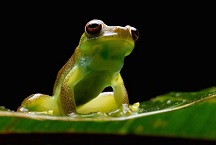 QUITO, ECUADOR—There is natural beauty everywhere at Mashpi Lodge near Quito, Ecuador. But there is more—much more—including scientific research and findings of interest not only to guests but also to the scientific community. A recent discovery at the 3,200-acre Mashpi Rainforest Biodiversity Reserve surrounding the Mashpi Lodge has everybody hopping. It is a new species of treefrog: Mashpi Torrenteer (Hyloscirtus mashpi).
QUITO, ECUADOR—There is natural beauty everywhere at Mashpi Lodge near Quito, Ecuador. But there is more—much more—including scientific research and findings of interest not only to guests but also to the scientific community. A recent discovery at the 3,200-acre Mashpi Rainforest Biodiversity Reserve surrounding the Mashpi Lodge has everybody hopping. It is a new species of treefrog: Mashpi Torrenteer (Hyloscirtus mashpi).
Carlos Morochz, Research Director at Mashpi, first saw Mashpi Torrenteer in 2011: “I sensed it was something different, so I went to Luis Coloma of Centro Jambau [an amphibian-focused research and conservation foundation in Quito] who suggested the frog required more detailed study.”
Led by Morochz, the research team at Mashpi began monitoring streams across the reserve. Photos were taken of individual frogs, revealing much color variation. Recordings were made of calls. Chytrid fungus, which infects amphibians, was analyzed. (Despite testing positive, the population is sizable.) Blood samples were taken for genetic and molecular studies, confirming a new species. With its description, the frog was assigned conservation priorities.
Most significant for the scientific community were videos of reproductive behavior. Quite a behavior it turned out to be: “Males of Torrenteers of the bogotensis group have a gland on the chin that was suspected to be used to stimulate the female at the time of courtship,” noted Mauricio Correa Rivera, co-author and researcher at the Herpetological Group of Antioquia in Colombia. “We now have evidence. This becomes an unprecedented record of the natural history of these enigmatic species.”
‘Quite Abundant’ in Mashpi Reserve
As described in the Neotropical Biodiversity Journal, Mashpi Torrenteer is associated with water bodies. It calls at night along stream banks, is quite abundant in the Mashpi Reserve, and has a reproductive cycle that goes throughout the year. The frog’s habitat is located in the Ecuadorian Chocó forest, one of the most threatened ecosystems in Ecuador and South America beyond. Indeed, due to urban sprawl deforestation, monocultures and logging, less than 2 percent of the Ecuadorian Chocó remains intact.
This last tidbit in particular confirms the importance of conserving the Mashpi Reserve and forests like it. Said Roque Sevilla, member of the board of Mashpi and mentor of the project: “This has all been a great joy because it endorses what I felt the first time I went to Mashpi: It is a sublime place full of life and biological value, much of which has not been registered by science or perceived by Ecuadorians like myself. I felt a moral obligation and great desire to preserve such a rich area.
“Travelers who pass through the experience at Mashpi become true ambassadors of nature conversation, which is a major success,” Sevilla continued. “Our aim is to show that it is possible to carry out a viable economic project and still be respectful of our environment. Both aspects are being achieved at Masphi.”
The scientific paper describing the new species was published on August 28, 2015, in Neotropical Biodiversity Journal, an initiative from the Ecuadorian Secretary of Higher Education, Science, Technology and Innovation to promote the publication and dissemination of biodiversity research in Latin America.
Go to Mashpi Lodge.






